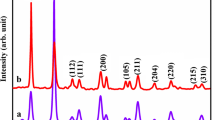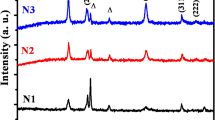Abstract
In the present work, the effect of reaction temperature and urea concentration on the electrochemical performance of NiO nanoparticles is investigated. The NiO nanosheets are synthesized by a facile and economical, hydrothermal method. The structural and morphological characterizations of the synthesized nanoparticles are done by X-ray diffraction (XRD), Raman spectroscopy, field emission scanning electron microscopy (FESEM) and Brunauer–Emmett–Teller (BET) analysis. The nanosheet morphology is developed when NiO is synthesized at 110 °C by kee** 01:02 proportion of nickel nitrate and urea in the growth solution. Formation of multiple highly porous microspheres is observed when NiO is grown directly on the nickel foam. The electrochemical performance of the developed electrodes is analysed by cyclic voltammetry (CV), galvanostatic charge–discharge (GCD) and electrochemical impedance spectroscopy (EIS). The binder-free electrode prepared by using these NiO nanosheets is able to display a magnificent specific capacity of 408 C/g (815 F/g) at 10 mV/s and 418 C/g (1045F/g) at 1 A/g. This electrode has shown a noteworthy cyclic stability by retaining 87.5% of its specific capacity after 1000 cycles, even at a high current density of 14A/g. The electrochemical performance of binder-enriched and binder-free electrodes and their dependence on the morphology of the NiO nanoparticles are analysed and discussed in this work. The asymmetric supercapacitor is assembled by considering NiO nanosheet-based electrode as anode, activated carbon-based electrode as the cathode and 6 M KOH/PVA-based gel as electrolyte. The asymmetric supercapacitor has delivered a maximum energy density of 22.5 Wh/kg at 0.9 kW/h.








Similar content being viewed by others
References
Vadiyar MM, Bhise SC, Kolekar SS et al (2016) Low cost flexible 3-D aligned and cross-linked efficient ZnFe2O4 nano-flakes electrode on stainless steel mesh for asymmetric supercapacitors. J Mater Chem A Mater 4:3504–3512. https://doi.org/10.1039/c5ta09022a
Augustyn V, Simon P, Dunn B et al (2014) Pseudocapacitive oxide materials for high-rate electrochemical energy storage. Energy Environ Sci 7:1597–1614. https://doi.org/10.1039/c3ee44164dï
Yang Q, Li Q, Yan Z et al (2014) High performance graphene/manganese oxide hybrid electrode with flexible holey structure. Electrochim Acta 129:237–244. https://doi.org/10.1016/j.electacta.2014.02.113
Li J, Chen Y, Liu Y (2012) Research on a stand-alone photovoltaic system with a supercapacitor as the energy storage device. In: Energy Procedia. Elsevier Ltd, pp 1693–1700. https://doi.org/10.1016/j.egypro.2012.01.262
Zhang Y, Feng H, Wu X et al (2009) Progress of electrochemical capacitor electrode materials: a review. Int J Hydrogen Energy 34:4889–4899. https://doi.org/10.1016/j.ijhydene.2009.04.005
Shi F, Li L, Wang XL et al (2014) Metal oxide/hydroxide-based materials for supercapacitors. RSC Adv 4:41910–41921. https://doi.org/10.1039/c4ra06136e
Guo XL, Kuang M, Dong F, Zhang YX (2016) Monodispersed plum candy-like MnO2 nanosheets-decorated NiO nanostructures for supercapacitors. Ceram Int 42:7787–7792. https://doi.org/10.1016/j.ceramint.2016.01.213
Pei L, Yang Y, Chu H et al (2016) Self-assembled flower-like FeS2/graphene aerogel composite with enhanced electrochemical properties. Ceram Int 42:5053–5061. https://doi.org/10.1016/j.ceramint.2015.11.178
Wu X, Yao S (2017) Flexible electrode materials based on WO3 nanotube bundles for high performance energy storage devices. Nano Energy 42:143–150. https://doi.org/10.1016/j.nanoen.2017.10.058
Liu Y, Hu P, Liu H et al (2019) Toward a high performance asymmetric hybrid capacitor by electrode optimization. Inorg Chem Front 6:2824–2831. https://doi.org/10.1039/c9qi00927b
Zhao D, Dai M, Liu H et al (2019) Sulfur-induced interface engineering of hybrid NiCo2O4@NiMo2S4 structure for overall water splitting and flexible hybrid energy storage. Adv Mater Interfaces. https://doi.org/10.1002/admi.201901308
Deng W, Liu Y, Zhang Y et al (2012) Enhanced electrochemical capacitance of nanoporous NiO based on an eggshell membrane. RSC Adv 2:1743–1745. https://doi.org/10.1039/c2ra00885h
Yan X, Tong X, Wang J et al (2014) Synthesis of mesoporous NiO nanoflake array and its enhanced electrochemical performance for supercapacitor application. J Alloys Compd 593:184–189. https://doi.org/10.1016/j.jallcom.2014.01.036
Miller EL, Rocheleau RE (1997) Electrochemical behavior of reactively sputtered iron-doped nickel oxide. J Electrochem Soc 144. https://doi.org/10.1149/1.1837961
Subramanian B, Mohamed Ibrahim M, Senthilkumar V et al (2008) Optoelectronic and electrochemical properties of nickel oxide (NiO) films deposited by DC reactive magnetron sputtering. Physica B Condens Matter 403:4104–4110. https://doi.org/10.1016/j.physb.2008.08.014
Li Q, Wang LS, Hu BY et al (2007) Preparation and characterization of NiO nanoparticles through calcination of malate gel. Mater Lett 61:1615–1618. https://doi.org/10.1016/j.matlet.2006.07.113
Aslani A, Oroojpour V, Fallahi M (2011) Sonochemical synthesis, size controlling and gas sensing properties of NiO nanoparticles. Appl Surf Sci 257:4056–4061. https://doi.org/10.1016/j.apsusc.2010.11.174
Dhas SD, Maldar PS, Patil MD et al (2020) Synthesis of NiO nanoparticles for supercapacitor application as an efficient electrode material. Vacuum. https://doi.org/10.1016/j.vacuum.2020.109646
Ali A, Ammar M, Mukhtar A et al (2020) 3D NiO nanowires@NiO nanosheets core-shell structures grown on nickel foam for high performance supercapacitor electrode. J Electroanal Chem. https://doi.org/10.1016/j.jelechem.2019.113710
Ci S, Wen Z, Qian Y et al (2015) NiO-microflower formed by nanowire-weaving nanosheets with interconnected Ni-network decoration as supercapacitor electrode. Sci Rep. https://doi.org/10.1038/srep11919
Cao F, Pan GX, **a XH et al (2014) Synthesis of hierarchical porous NiO nanotube arrays for supercapacitor application. J Power Sources 264:161–167. https://doi.org/10.1016/j.jpowsour.2014.04.103
Du D, Hu Z, Liu Y et al (2014) Preparation and characterization of flower-like microspheres of nano-NiO as electrode material for supercapacitor. J Alloys Compd 589:82–87. https://doi.org/10.1016/j.jallcom.2013.11.176
Ibupoto ZH, Elhag S, AlSalhi MS et al (2014) Effect of urea on the morphology of CO3O4 nanostructures and their application for potentiometric glucose biosensor. Electroanalysis 26:1773–1781. https://doi.org/10.1002/elan.201400116
Pilban Jahromi S, Pandikumar A, Goh BT et al (2015) Influence of particle size on performance of a nickel oxide nanoparticle-based supercapacitor. RSC Adv 5:14010–14019. https://doi.org/10.1039/c4ra16776g
Allagui A, Alami AH, Baranova EA, Wüthrich R (2014) Size-dependent capacitance of NiO nanoparticles synthesized with cathodic contact glow discharge electrolysis. J Power Sources 262:178–182. https://doi.org/10.1016/j.jpowsour.2014.03.104
Ascencio F, Bobadilla A, Escudero R (2019) Study of NiO nanoparticles, structural and magnetic characteristics. Appl Phys A Mater Sci Process. https://doi.org/10.1007/s00339-019-2579-8
Burmistrov I, Agarkov D, Tartakovskii I et al (2015) Performance optimization of cermet SOFC anodes: an evaluation of nanostructured NiO. ECS Trans 68:1265–1274. https://doi.org/10.1149/06801.1265ecst
Saraf M, Natarajan K, Mobin SM (2018) Emerging robust heterostructure of MoS2-rGO for high-performance supercapacitors. ACS Appl Mater Interfaces 10:16588–16595. https://doi.org/10.1021/acsami.8b04540
Cuervo-Reyes E, Scheller CP, Held M, Sennhauser U (2015) A unifying view of the constant-phase-element and its role as an aging indicator for Li-Ion batteries. J Electrochem Soc 162:A1585–A1591. https://doi.org/10.1149/2.0791508jes
Kumar P, Sharma S, Jabeen S, Samra KS (2022) Hybrid microwave annealing assisted synthesis of MoS2-RGO nanostructures: Optimization and characterization for application in supercapacitors. Electrochim Acta 426. https://doi.org/10.1016/j.electacta.2022.140738
Vijayakumar S, Nagamuthu S, Muralidharan G (2013) Supercapacitor studies on NiO nanoflakes synthesized through a microwave route. ACS Appl Mater Interfaces 5:2188–2196. https://doi.org/10.1021/am400012h
Li QQ, Fan RH, Yan KL et al (2015) Preparation of NiO microspheres by hydrothermal method and its electrochemical capacitive properties. Mater Sci Forum 814:81–85. https://doi.org/10.4028/www.scientific.net/msf.814.81
Yu W, Jiang X, Ding S, Li BQ (2014) Preparation and electrochemical characteristics of porous hollow spheres of NiO nanosheets as electrodes of supercapacitors. J Power Sources 256:440–448. https://doi.org/10.1016/j.jpowsour.2013.12.110
Gunasekaran SS, Gopalakrishnan A, Subashchandrabose R, Badhulika S (2021) Phytogenic generation of NiO nanoparticles as green-electrode material for high performance asymmetric supercapacitor applications. J Energy Storage. https://doi.org/10.1016/j.est.2021.102412
Funding
The authors are thankful to the Central Instrumentation Facility (CIF), Division of Research and Development (DRD), Lovely Professional University, India, for providing the characterization facilities and funds under the scheme LPU/DRDSEED/SAC/65. Further, the authors also want to thank the Council of Scientific and Industrial Research, New Delhi, India, for providing the funding assistance under the EMR scheme (Grant number: 03(1469)/19/EMR-II).
Author information
Authors and Affiliations
Corresponding author
Ethics declarations
Compliance with ethical standards
All authors certify that they have no affiliations with or involvement in any organization or entity with any financial interest or non-financial interest in the subject matter or materials discussed in this manuscript.
Competing interests
The authors declare no competing interests.
Additional information
Publisher's Note
Springer Nature remains neutral with regard to jurisdictional claims in published maps and institutional affiliations.
Supplementary Information
Below is the link to the electronic supplementary material.
Rights and permissions
Springer Nature or its licensor (e.g. a society or other partner) holds exclusive rights to this article under a publishing agreement with the author(s) or other rightsholder(s); author self-archiving of the accepted manuscript version of this article is solely governed by the terms of such publishing agreement and applicable law.
About this article
Cite this article
Sheokand, S., Kumar, P., Jabeen, S. et al. 3D highly porous microspherical morphology of NiO nanoparticles for supercapacitor application. J Solid State Electrochem 27, 727–738 (2023). https://doi.org/10.1007/s10008-022-05366-w
Received:
Revised:
Accepted:
Published:
Issue Date:
DOI: https://doi.org/10.1007/s10008-022-05366-w




